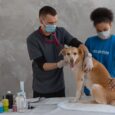IVDD, or intervertebral disc disease, is a genetic condition in which the discs between the vertebrae stiffen and become fragile. They can no longer cushion the vertebrae and instead flatten or bulge and can damage and release their hardened components into the spinal cord region. It puts pressure on the spinal cord, which can cause pain, loss of some functions, including bowel and bladder control, or even paralysis.
Different Types of Treatment for IVDD
Treatment varies depending on the nature of the symptoms. Oral anti-inflammatory medicines and cage rest are advised for dogs with mild issues and often improve within 48 hours. Dogs with cervical IVDD with low functional disability are considered surgical candidates. Myelography and surgery are recommended for dogs that have not responded to medicine and have more severe or worsening symptoms.
Surgery is effective at relieving pain, removing spinal cord compression, and increasing the likelihood of patient recovery. Veterinary neurology in Lexington experts will work together with your veterinarian to identify the most appropriate care for your pet if they have disk complications.
Medications
Some dogs may benefit from anti-inflammatory medicine in less difficult situations to minimize swelling in the spinal cord, soothe pain, and more. This treatment is typically accompanied by strict crate rest and no activity for approximately six weeks. Many dogs will respond well to non-surgical treatment and will be able to resume normal activities. Still, harnesses for walking may be recommended, as well as steps or ramps to reduce jumping on and off furniture and beds.
Surgery
Vet surgery is typically needed for dogs with more severe cases of Intervertebral Disc Disease where rest and medicines are insufficient to relieve pain. During surgery, your veterinary surgeon will extract the hardened disc material that is pressing on your dog’s spine, leading to the IVDD symptoms. Surgery results are best in dogs who have not lost their ability to walk.
If your dog’s operation does not restore normal mobility, a dog wheelchair can aid your pup in living a happy and active life while dealing with this type of disease. IVDD surgery recuperation takes 6 to 8 weeks of restricted activity. Running, climbing stairs, or having fun with other pets must be avoided to reduce further damage while your dog’s spine recovers.
Physical Therapy
Following surgery, your veterinarian may also propose physical therapy for your dog to help with muscle strengthening and getting your pet moving comfortably again. A couple of physical therapy activities can aid with IVDD. You may be able to do these workouts with your pet in your home, but keep an eye out for indications of pain.
Confirm with your veterinarian the exercises your pet can perform. Work with a veterinary physical therapist or rehab institution. The ability of your dog to perform these activities depends on the degree of its health problem.
Final Thoughts
As a pet owner with a dog diagnosed with minor or severe IVDD, you are probably facing some difficult decisions for your beloved pet. Your veterinarian will assess the different treatment alternatives and the expected results. Whether you choose surgery or non-surgical, looking after a dog with IVDD is essential to help speed recovery and improve the overall outcome of treatment.





